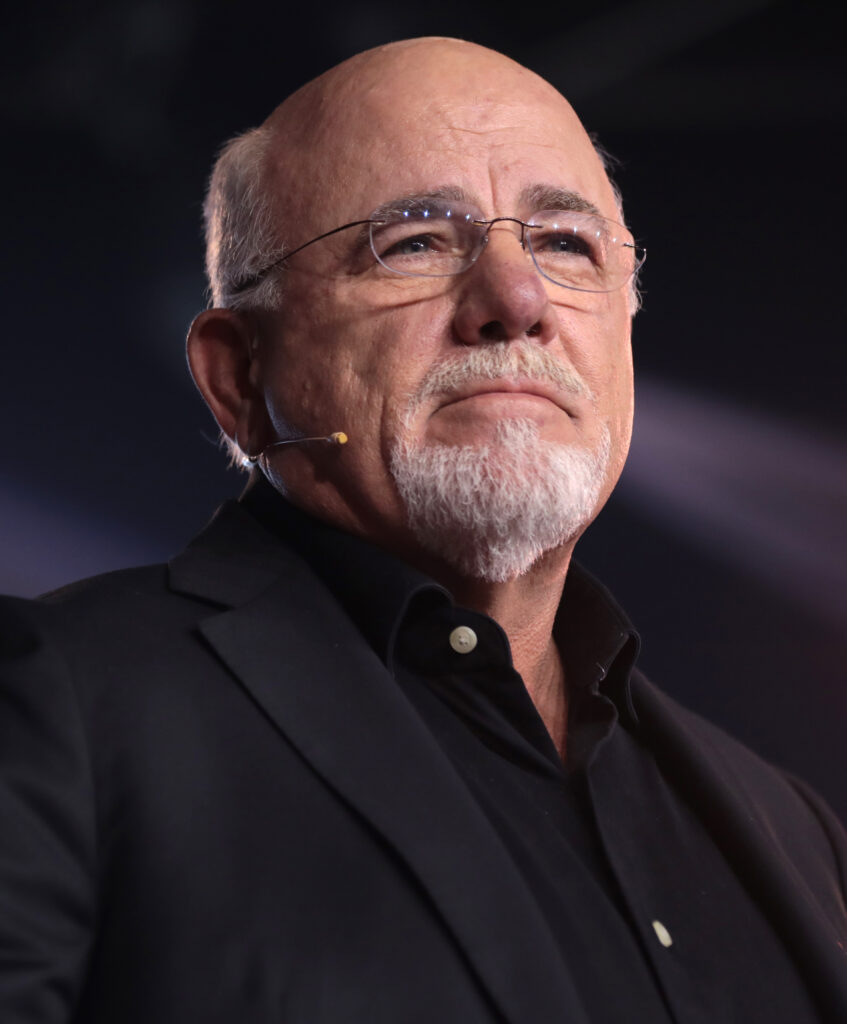Table of Contents
- Who is Dave Ramsey
- Why Does Dave Ramsey Avoid Debt
- Dave’s Framework for Financial Peace
- Step 1: Establish a starter Emergency Fund
- Step 2: Pay off all debt (excluding your mortgage) using the Debt Snowball method
- The Debt Snowball method
- Step 3: Save 3 to 6 months of expenses in a fully funded emergency fund
- Step 4: Invest 15% of your household income towards retirement
- Step 5: Save for Children’s College Fund
- Step 6: Pay off your house
- Step 7: Build Wealth & Give
- Final Thoughts
Who is Dave Ramsey
Dave Ramsey is a 63 year old Billionaire with a media empire and an extensive portfolio of Real Estate to his name. His media empire features his own talk show “The Ramsey Show” where the primary topic is financial literacy and getting out of debt. The Ramsey show is based in Tennessee, USA as is Dave. The show allows Americans (I have seen a few calls from Canada as well) to call in and ask Dave and his Ramsey Show co-hosts, questions related to their finances.
The calls are for the most part, about how to get out of debt and get back on track. Dave or his co-host (if Dave isn’t around) will typically ask the caller to break down their debt such as “how much is in credit cards, how much is in car loans, student loans, etc.” They will then ask what the caller’s household income is and from there they come up with a plan, live and on air, as to how to get them on track.
The Ramsey Show has over 600,000 subscribers on Youtube (where I first discovered and continue to consume Dave Ramsey’s content and wisdom).

Why Does Dave Ramsey Avoid Debt
To answer this question, we have to go back to 18 year old Dave in the late 70s and early 80s, who just got his Real Estate License. Dave’s parents were also in the Real Estate business. Dave even went as far as studying Real Estate in school. Dave went on to get married at 22 years old in 1982 and had a Million dollar net worth at 24 years old (1984). He made income of $250,000 as a 24 year-old. He was taking out 90 day loans for his “quick flips” of property.
By the way, Dave was putting 0% down on the Real Estate he was buying and flipping. The largest bank he was using (he had $1.2 million of debt with them) got sold to another bank. The banker there noticed that there was a 24 year old kid who owed them a lot of money. They decided to “limit that relationship”, meaning they called the notes and demanded payment in full of the outstanding loan. Another bank Dave had loans with caught wind of this and decided to do the same.
Dave Ramsey, in his mid 20s, had to come up with $2 million dollars in 120 days. This started a crash that he couldn’t recover from. He spent the the next two and a half years being foreclosed on and losing everything that he owned. At the time he had two kids (a newborn and a toddler) and a marriage that was hanging by a thread. He and his wife decided to file for bankruptcy.
Learning from Scripture
In September of 1988, Dave Ramsey began studying what the Bible says about money. He and his wife were new to the Christian faith at the time. Dave learned that the bible’s views on money are as follows: get out of debt, stay out of debt, live on less than you make, live on a budget and have a plan. He followed these principles and began improving his financial situation. Dave started to receive questions from people asking him how he was able to recover from bankruptcy. These were people who also hit rock bottom, similar to Dave.
Teaching Financial Literacy & Serving the Community
Dave started out sitting down and helping some friends set up a budget. He also got a call from the pastor at his church asking if he could help someone in foreclosure, to which he agreed. He also started doing forebearance plans for people behind on their mortgage and struggling, effectively saving them from filing for bankruptcy. Dave began teaching financial literacy at Sunday school where the class started at 4 people and eventually became 300 people. He went on a radio show working for free and wrote a book that he sold while on that show. He also began doing events. 30 years later that radio show is now “The Ramsey Show”.
From Free Advice to Billion Dollar Business
Word eventually got out about Dave helping people with their stressful financial problems and he started charging from 250 to 750 dollars to sit down with someone and help them. They called it counselling back then but now refer to it as coaching.
The radio show didn’t become profitable for 10 years. The radio show did however, become a megaphone to acquire customers as a lot of people were listening. People would come in for coaching, but they also sold books, and started doing events as well. Dave Ramsey and company came up with a 26 week course on money called “Life after Debt” which is now known as “Financial Peace University” (now 9 week course).
Over time, the course grew, the publishing, events and speaking grew as well. Eventually the radio show became profitable and they were able to sell ads.
They found different mediums to help people and then figured out if it was possible to monetize that medium. Financial Peace University was first on video (VHS), later (DVD) and now is digitally delivered of course (online and via app). The Ramsey team realized the ability to scale the business as they shifted through the methods of course delivery.
Ramsey Solutions now has 1200 employees. Dave has brought on “Ramsey Personalities” including his daughter, Rachel Cruz. He learned that it was important to have a succession plan to continue to help people even after he’s long gone. His “Personalities” and Ramsey Show co-hosts are best-selling authors and offer their own unique perspective on personal finance.
Dave’s Framework for Financial Peace
Over the years, Dave Ramsey has come up with and tweaked his framework for financial peace. This framework has helped people all across the United States and is more commonly referred to as “7 baby steps to financial peace”.
Step 1: Establish a starter Emergency Fund
Your starter emergency fund should consist of just $1,000. This exists for multiple reasons. The first reason is to aid you in the event that while you begin on step 2 (pay off all your debt excluding your mortgage), you suffer a small financial emergency. This could be having car trouble and having to replace parts for under $1,000. If you did not have a starter emergency fund, you would have taken out debt to cover the cost of this emergency. Another reason this is the first step in the process is that it’s not too big that it seems overwhelming, but it’s also big enough that you feel good about saving $1,000.
Step 2: Pay off all debt (excluding your mortgage) using the Debt Snowball method
This is the most powerful step in my opinion. Many people who find and gravitate towards Dave Ramsey do so because they are in a lot of debt that can be overwhelming to say the least. Dave is one of the few mainstream resources online, for people who are in tough financial situations.
The Debt Snowball method
The Debt snowball method is when you arrange all of your debts from smallest to largest. You can ignore the interest rates. You will pay the minimum payment on all of your debts except the smallest one. The smallest one you will attack with all of your excess cash-flow until you clear it. As you do this for each and every debt, you will have a snowball forming that gets bigger and bigger in terms the amount of money you can attack each consecutive debt with.
Step 3: Save 3 to 6 months of expenses in a fully funded emergency fund
This step is where you create your fully funded emergency fund. This fund exists to protect you against curveballs that life throws your way. Some of these emergencies could be losing your job or your car breaking down. Whatever your absolute necessary expenses are, such as housing costs, food, transportation, debt obligations — your emergency fund should cover 3 to 6 months worth of these expenses.
Step 4: Invest 15% of your household income towards retirement
This step is straight forward. Now you can finally start to invest. Everyone wants to invest but no one wants to pay off large amounts of debt.
Investing is an interesting word. In my opinion, the word “investing” can be referring to many different things. To me, the first thing that comes to mind when I hear the word “investing”, is putting your money to work in the stock market. To others, investing may be strictly related to real estate. Now, why is that? The stock market in their mind could not be a productive investment vehicle due to all the horror stories they’ve been told.
Mutual Funds
For the purposes of this step, Dave is referring to investing in the stock market — specifically in mutual funds. In my opinion, there are pros and cons to investing in mutual funds.
| Pros | Cons |
| Someone else manages your money. Peace of mind. This can be a positive thing for someone new to investing their money. For beginners, the stock market can seem overwhelming and making deposits or regular contributions to someone you trust to grow your finances, can be the best option for a lot of people. | Fees The Management Expense Ratio (MER) can range from 1% to 3%. You don’t pay these expenses directly, but they can reduce the fund’s returns which adds up over time. |
| Better Returns versus High yield savings account/GIC or doing nothing When you leave your money in the bank/ in your checking account — maybe you can get a 2% return (best case scenario, worst case: 0%) When you put your money in a high yield savings account — you can get up to 5% and the same with a GIC. With a mutual fund that is focused on growth/mirroring the S&P 500, you could reasonably expect 8-10% returns annually before fees. | Not Guaranteed to Outperform Benchmark When you invest into a mutual fund, it is actively managed. An actively managed fund aims to outperform the S&P 500 index. Historically, the S&P has provided 8 to 10% returns annually. If after fees, your returns are below this over a long period of time, you were probably better off buying an index fund or index ETF (which give you better results while avoiding the excess fees) |
Step 5: Save for Children’s College Fund
Assuming you have children, the point of this step is to save for your child’s college or university tuition so you are not scrambling to sell your investments or blow through your emergency fund to pay for your children’s schooling. At this point, surely with the momentum you’ve built up, you don’t want your children taking out debt to pay for school.
Step 6: Pay off your house
Dave Ramsey’s company Ramsey Solutions, has a mortgage payoff calculator on their website that is helpful with this step. You can check it out here: Mortgage Payoff Calculator.
Paying off your mortgage early will minimize your largest expense. Sure, you have property tax, utilities, maintenance and repairs to pay for, but your life has now gotten a whole lot easier, financially.
Step 7: Build Wealth & Give
You’ve already been building wealth by increasing the gap between your Income and expenses on your way here. Now you can just get a little more aggressive with how much you’re investing. You can also begin to truly give back to society in meaningful ways.
Final Thoughts
There are many people all over the internet that have negative opinions about Dave Ramsey. In my opinion, what he does is a net positive. The topic of debt is hard for many people to speak about. The Ramsey Show gave people in debt a positive outlet to not only get it off their chest, but also receive advice on how to proceed. When you look at the people around you, there is a high chance that someone is struggling with their own debt situation. The way keep these things hidden its as if they committed a crime. However, as quick as debt can snowball to become a real problem, it can also get paid off.
People may critique Dave for his “limiting” advice. They may be unaware that he has a whole separate platform dedicated to entrepreneurship called “EntreLeadership”. Nobody is forced to listen to Dave Ramsey’s advice. Most people have no one else to turn to that is an expert on personal finance. Dave Ramsey provides this advice for free in most cases.
We all know that personal finance is not taught in school. If it were, there would hardly be any credit card debt in the world and most people would be retired by 45. Due to the reality that we live in, Dave Ramsey and his media empire is very much necessary if you ask me.







